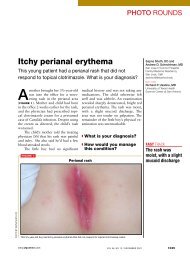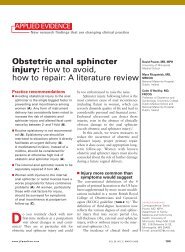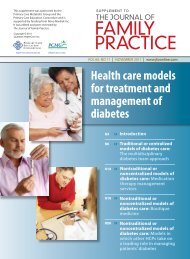Management of morbid obesity - The Journal of Family Practice
Management of morbid obesity - The Journal of Family Practice
Management of morbid obesity - The Journal of Family Practice
You also want an ePaper? Increase the reach of your titles
YUMPU automatically turns print PDFs into web optimized ePapers that Google loves.
<strong>Management</strong> <strong>of</strong> <strong>morbid</strong> <strong>obesity</strong>: <strong>The</strong> role <strong>of</strong> bariatric surgery<br />
TABLE 2<br />
NIH guidelines for treatment <strong>of</strong> <strong>obesity</strong><br />
BMI (kg/m 2 )<br />
25-26.9 27-29.9 30-34.9 35-39.9 ≥40<br />
Lifestyle Yes, with ≥2 Yes, with ≥2<br />
therapy risk factors or risk factors or Yes Yes Yes<br />
co<strong>morbid</strong>ities co<strong>morbid</strong>ities<br />
Drug Yes, with<br />
therapy* No risk factors or Yes Yes Yes<br />
co<strong>morbid</strong>ities<br />
Bariatric No No No Yes, with Yes<br />
surgery co<strong>morbid</strong>ities<br />
*Drug therapy is indicated in patients who fail to lose 0.45 kg a week during 6 months <strong>of</strong> lifestyle therapy.<br />
Adapted from NHLBI Obesity Education Initiative. <strong>The</strong> Practical Guide to the Identification, Evaluation,<br />
and Treatment <strong>of</strong> Overweight and Obesity in Adults. NIH Publication No. 00-4084. October 2000.<br />
greater than patients taking placebo (95% CI, 2.3-<br />
3.1). 49 Attrition rates ranged from 14% to 52% (average,<br />
33%). Orlistat is associated with a high incidence<br />
<strong>of</strong> gastrointestinal side effects; they occurred 16% to<br />
40% more <strong>of</strong>ten in orlistat patients than in placebo<br />
patients. <strong>The</strong> most common <strong>of</strong> these, occurring in 15%<br />
to 30% <strong>of</strong> patients taking orlistat, were fatty/oily stool,<br />
fecal urgency, and oily spotting. Fecal incontinence<br />
occurred in 6% <strong>of</strong> patients in the 3 studies that reported<br />
this side effect.<br />
Most orlistat trials also excluded patients with<br />
BMIs greater than 40 kg/m 2 , which limits application <strong>of</strong><br />
these data to patients with class III <strong>obesity</strong>. 49 Both orlistat<br />
and sibutramine may improve quality-<strong>of</strong>-life parameters<br />
and may have a modest beneficial impact on lipid<br />
levels and metabolic parameters (eg, blood glucose,<br />
hemoglobin A 1c). However, discontinuation <strong>of</strong> therapy<br />
is associated with return <strong>of</strong> previously lost weight. 49<br />
Alternative therapies<br />
Obese patients <strong>of</strong>ten turn to alternative therapies such as<br />
hypnosis, acupuncture, and over-the-counter dietary supplements.<br />
Studies <strong>of</strong> hypnosis and acupuncture have<br />
shown that these techniques do not provide consistent<br />
improvement over placebo (ie, sham procedure). 50,51<br />
Over-the-counter dietary supplements that have been<br />
studied include chitosan, chromium picolate, Ephedra<br />
8 Supplement to <strong>The</strong> <strong>Journal</strong> <strong>of</strong> <strong>Family</strong> <strong>Practice</strong> March 2005<br />
sinica, Garcinia cambogia,<br />
glucomannan, guar gum,<br />
hydroxy-methyl butyrate,<br />
plantago psyllium, pyruvate,<br />
yerba maté, and yohimbe. A<br />
systematic review <strong>of</strong> such<br />
studies concluded that none<br />
<strong>of</strong> these agents have shown<br />
consistent results in promoting<br />
weight loss; moreover,<br />
safety is a significant concern<br />
with several <strong>of</strong> them. 52 Thus,<br />
they cannot be recommended<br />
for use in clinical practice,<br />
at least until further research<br />
has been performed.<br />
Psychotherapy<br />
Structured psychotherapy<br />
aimed at weight reduction includes behavioral modification<br />
techniques (eg, stimulus control, self-monitoring,<br />
and cognitive restructuring) that increase compliance<br />
with dietary changes, exercise regimens, or both. 53 No<br />
one technique has been proven superior when judged by<br />
the amount <strong>of</strong> weight lost. 6 <strong>The</strong> majority <strong>of</strong> weight loss in<br />
patients undergoing psychotherapy and supervised<br />
lifestyle change occurred during the first year <strong>of</strong> treatment.<br />
At 5-year follow-up, there was no statistically significant<br />
difference between intervention and control<br />
groups. 6 Programs with the most patient contact tended<br />
to produce the largest weight loss. 6<br />
Summary<br />
<strong>The</strong> family physician is <strong>of</strong>ten the <strong>morbid</strong>ly obese patient’s<br />
first contact with the health care system, there by providing<br />
an opportunity to influence management in a patientoriented<br />
manner that focuses on outcomes such as weight<br />
loss, associated co<strong>morbid</strong>ities, and quality <strong>of</strong> life.<br />
Nonsurgical treatments for <strong>morbid</strong> <strong>obesity</strong> have significant<br />
limitations including minimal total weight loss, little<br />
or no effect on co<strong>morbid</strong>ities and quality <strong>of</strong> life, and lack<br />
<strong>of</strong> sustainment over time. Bariatric surgery, on the other<br />
hand, <strong>of</strong>fers greater and longer-lasting weight loss 54 and<br />
better improvement in clinically relevant outcomes. 21,22<br />
Sackett wrote that evidence-based medicine is “the<br />
integration <strong>of</strong> the best research evidence with clinical









